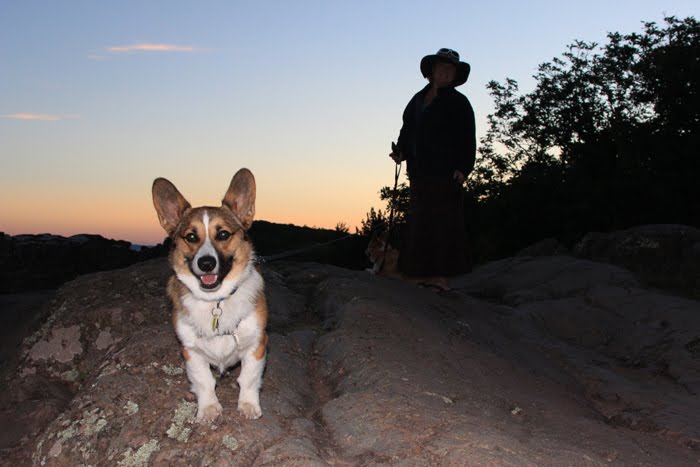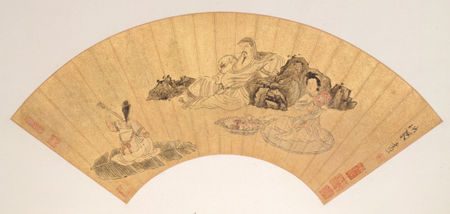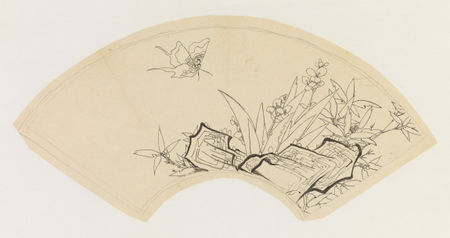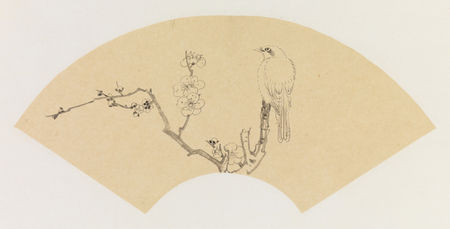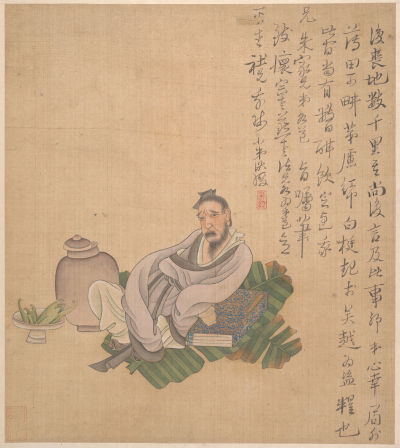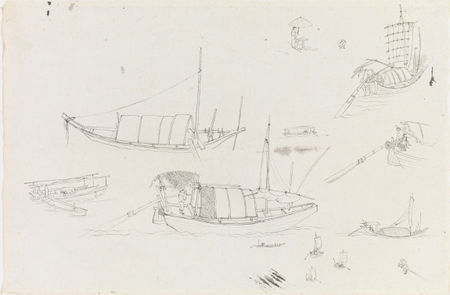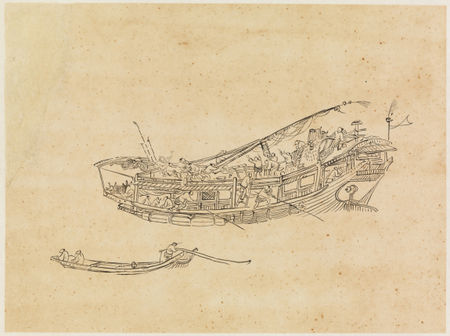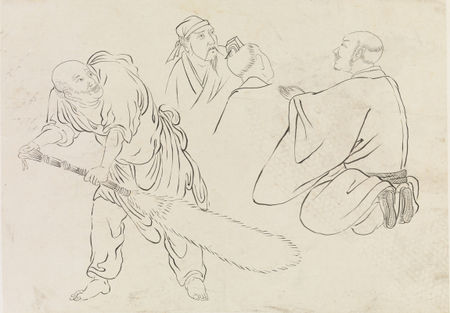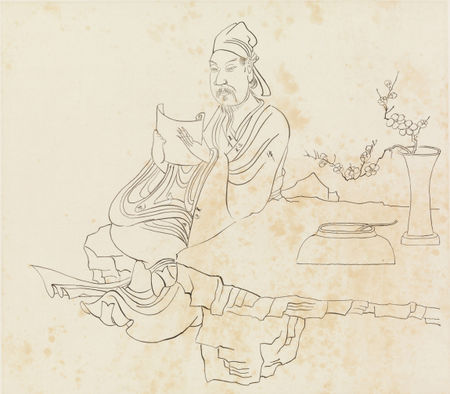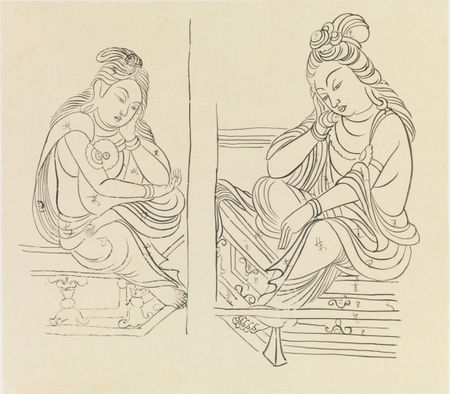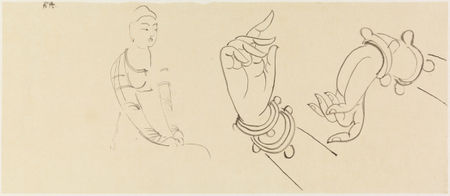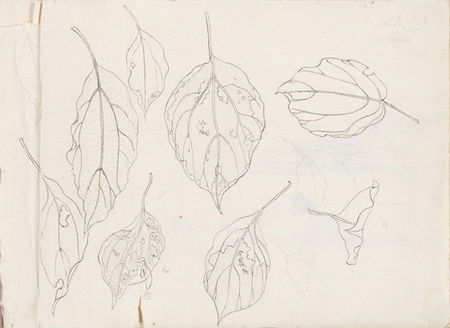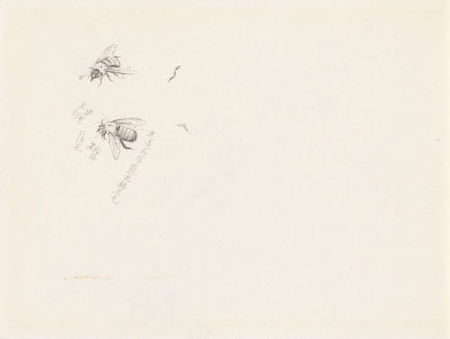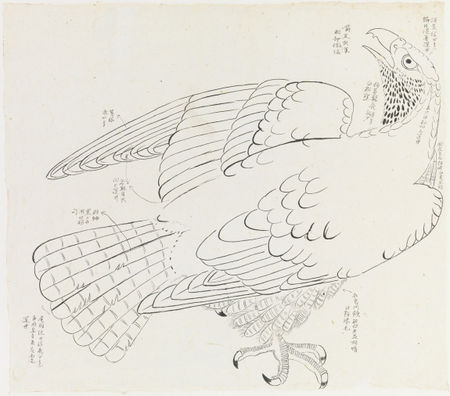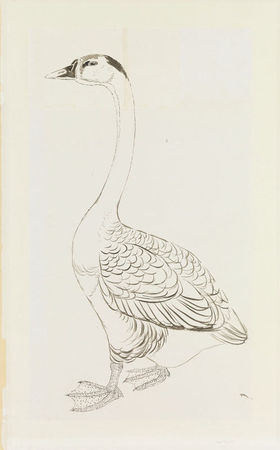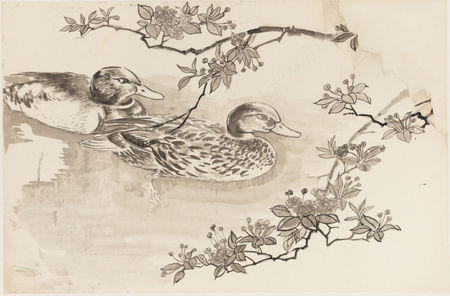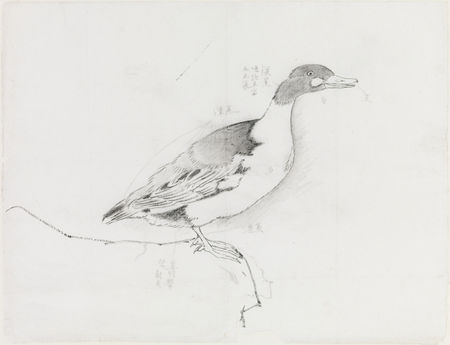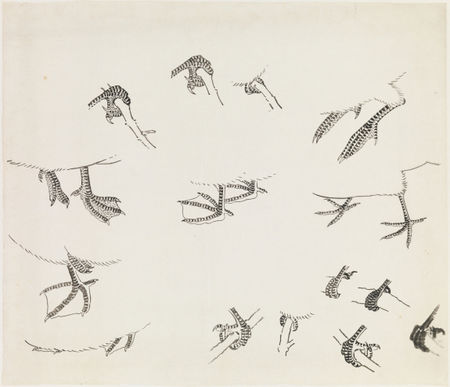 Xie Zhiliu (Chinese, 1910–1997), Dwelling in the Mountains. Dated 1979. Hanging scroll; ink and color on paper.
Xie Zhiliu (Chinese, 1910–1997), Dwelling in the Mountains. Dated 1979. Hanging scroll; ink and color on paper.Mastering the Art of Chinese Painting: Xie Zhiliu (1910–1997)
February 6, 2010–August 1, 2010
Xie Zhiliu received a traditional Chinese artistic education, which combined the two disciplines of copying the work of earlier masters and drawing directly from life. His finished paintings, like those of many other Chinese artists, appear to be freehand creations—the work of a master draftsman who handled his brush with a confidence borne of years of practice. However, unlike many artists, Xie preserved numerous copies and sketches he made throughout his career, not only building a unique record of his creative process but also revealing how a seemingly spontaneous composition could be preceded by one or more sketches and drafts. These preparatory works could also serve as templates, thus liberating Xie from the need to visualize a completed composition in advance and allowing him to concentrate instead on making each of his brushstrokes as dynamic and fluid as possible. Juxtaposing Xie’s preparatory sketches with images of earlier models and with his own finished works, this exhibition seeks to demonstrate not only how traditional Chinese masters developed their personal styles through a combination of careful imitation and creative adaptation but also how they often relied on preparatory drawings to practice their craft—in a manner not dissimilar to that of Western painters.
More About the Artist
Xie Zhiliu was a native of Changzhou, a city with a strong tradition of bird-and-flower painting, a genre in which Xie excelled. Moving to Chongqing to escape the Japanese occupation in 1937, he became a close friend of a renowned painter Zhang Daqian (1899–1983), who introduced him to the Buddhist cave murals of the Silk Road oasis of Dunhuang. After the war, he became an advisor and preeminent connoisseur on painting and calligraphy for the Shanghai Museum as well as a professor of painting. Thanks to his access to the rich holdings of the museum, Xie expanded his style through the study of Tang, Song, and Yuan dynasty painting, a topic on which he published. Between 1983 and 1990 he led a team of scholars in evaluating the collections of China’s leading cultural institutions, which resulted in a twenty-four-volume illustrated index of more than seventy thousand paintings and calligraphies.
About the Installation
The installation is organized thematically. The first two galleries, entitled "Tracing the Past," present Xie’s early studies of figures, narratives, and bird-and-flower paintings of the Song dynasty (960–1279). His sketches of Buddhist figures based on his study of the Dunhuang murals are also included here. The artist’s admiration for the master painter Chen Hongshou (1599–1652) and other bird-and-flower specialists is highlighted in the subsequent two galleries with a number of precise copies of these artists' paintings. How Xie also learned directly from nature is illustrated in the fifth gallery. Featured are a number of studies of flowers and fruit as well as two albums of landscape sketches, capturing naturalistic compositions defined largely by contour lines with little interior modeling. Also on view in this section is a pencil sketch of narcissus visualized from different angles that show how his lines were slowly formed with numerous adjustments and corrections. Xie’s appreciation for cursive calligraphy is the focus of the next section. A manuscript called Poems of Inner Mongolia (1961) as well as several copies including Select Characters from Huaisu’s Autobiography (1969) and Notes on Zhang Xu dated to the late 1960s document Xie’s conscientious study of ancient models in the Shanghai Museum collection. The section concludes with Five Poems (1990), reflecting the abiding influence of these earlier masters. The final gallery features Xie’s integration of naturalism and stylization in his late years. Among the works on view is a brightly colored album called Views of Yosemite National Park, California (1994), which the artist made with his wife, the painter Chen Peiqiu (b. 1923), in 1994. Complementing the installation is a display of some of the artist's seals, which constitute a valuable anthology of the seal carver's art by many of the leading practitioners of the late twentieth century. This group also highlights one of the most innovative and important forms of calligraphy to be practiced since the late Ming dynasty.

From:
Noncanonical
East Meets the American West
Xie Zhiliu's Yosemite images.
By Morgan Meis
In the last room of the exhibit, where something special happens. In 1994, Xie traveled to Yosemite National Park with his painter wife Chen Peiqiu. There, he produced a series of paintings that are a testimonial to cognitive dissonance. He paints the mountains and trees of Yosemite, but they look vaguely Chinese. The vegetation looks sparse, like in the drawings that accompany Chinese calligraphy. The stones of Yosemite rise up with the stalagmite abruptness we expect of Chinese art.Stunning as the natural formations are, they've also been fully co-opted into human culture. Chinese artists, generation after generation, managed to create what they were looking at almost as much as they simply recorded it. They forced us, in their paintings and drawings, to pick out the landscape in particular ways, to value certain kinds of rocks and outcroppings more highly than others. Over the centuries, they became connoisseurs. Over the centuries, it became impossible to see that particular natural phenomenon through the eyes of anything but the tradition.
And that's what happened to Xie Zhiliu in Yosemite. He painted a Yosemite that simply doesn't exist, at least to those of us on the Western side of the globe. Actually, his Yosemite doesn't exist on the Eastern side, either. It exists only in Xie Zhiliu's head. His Chinese tradition was in a locked battle with a landscape he didn't recognize. Yosemite doesn't look like the mountains of China. The stone is different. The mountains came forth because of different geological forces. The foliage is made up of different species of tree and shrub. Reality doesn't show itself in Yosemite the same way it shows itself in Taishan Mountain. The paintings Xie Zhiliu made in Yosemite don't reconcile that confusion, they simply record it. One of the deepest ongoing philosophical and aesthetic problems is whether we have access to reality as it really is, or whether we always see our own version of it. In no ways can Xie Zhiliu's Yosemite paintings be said to solve this problem. They do reflect, however, what a wonderfully, productively, beautiful problem it is and, I suppose, ever shall be. • 29 April 2010
'Mastering the Art of Chinese Painting: Xie Zhiliu (1910–1997)' @ The Metropolitan Museum of Art

Chen Hongshou (Chinese, 1599–1652), Landscapes and Flowers. Late Ming–early Qing dynasty, first half of the 17th century. Twelve folding fans mounted as album leaves. Ink and color on gold paper.
Xie Zhiliu (Chinese, 1910–1997), Butterfly, Bamboo, Flowers, and Rock, after Chen Hongshou. Datable to the 1930s. Drawing; pencil and ink on tracing paper.
Xie Zhiliu (Chinese, 1910–1997), Bird on a Branch of Blossoming Plum, after Chen Hongshou. Datable to the 1930s. Drawing; ink and pencil on tracing paper.
Chen Hongshou (Chinese, 1599–1652) and Chen Zi (Chinese, 1634–1711), Figures, Flowers and Landscapes. Late Ming dynasty and early Qing dynasty, 17th–18th century, one leaf dated 1627. Album of eleven paintings; ink and color on silk.
Xie Zhiliu (Chinese, 1910–1997), Landscape in the Style of Liang Kai. Dated 1980. Hanging scroll; ink on paper
Xie Zhiliu (Chinese, 1910–1997), Studies of Boats and Figures. Datable to the 1930s. Drawing; pencil and ink on paper. Overall (b): 13 3/8 x 20 1/2 in. (34 x 52 cm) 2005.411.13 © 2000–2010 The Metropolitan Museum of Art
Xie Zhiliu (Chinese, 1910–1997), Boats. Datable to the 1930s. Drawing; ink on transparent paper. Overall: 29 15/16 x 20 in. (76 x 50.8 cm) 2005.411.52 © 2000–2010 The Metropolitan Museum of Art
Xie Zhiliu (Chinese, 1910–1997), Bodhidharma and Luohans, after Liang Kai's "Eight Eminent Monks", 20th century. Drawing; ink on tracing paper.
Xie Zhiliu (Chinese, 1910–1997), Gentleman Seated at a Stone Table, after Chen Hongshou. Datable to the 1930s. Drawing; ink on transparent paper.
Xie Zhiliu (Chinese, 1910–1997), Pensive Bodhisattvas, 20th century. Drawing; ink on transparent paper.
Xie Zhiliu (Chinese, 1910–1997), Heads, Datable to 1943 (detail). Drawing; ink on glassine paper.
Xie Zhiliu (Chinese, 1910–1997), Hands and Donor Figure. Datable to 1942–43. Drawing; ink on transparent paper.
Xie Zhiliu (Chinese, 1910–1997), Lady with an Elephant and Guardian with a Horse. Datable to 1942–43. Drawing; ink on transparent paper.
Xie Zhiliu (Chinese, 1910–1997), Leaf Studies, ca. 1930s. Sheet from a sketchbook; pencil and ink on paper. Overall (sketchbook closed):
Xie Zhiliu (Chinese, 1910–1997), Bamboo, ca. 1930s. Sheet from a sketchbook; pencil and ink on paper. Overall (sketchbook closed):
Xie Zhiliu (Chinese, 1910–1997), Study of a Bee, ca. 1930s. Sheet from a sketchbook; pencil on paper. Overall (sketchbook closed):
Xie Zhiliu (Chinese, 1910–1997), Hawk, 20th century. Drawing; ink on paper.
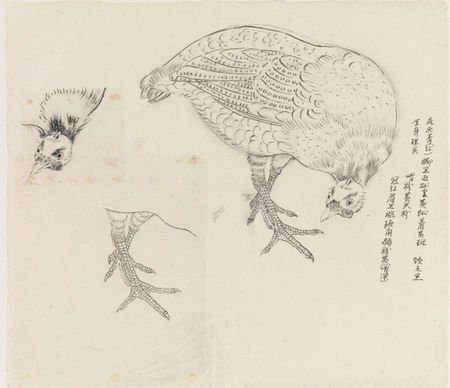
Xie Zhiliu (Chinese, 1910–1997), Studies of a Bird, 20th century. Drawing; ink and pencil on paper.
Xie Zhiliu (Chinese, 1910–1997), Goose, 20th century. Drawing; ink on tracing paper.
Xie Zhiliu (Chinese, 1910–1997), Ducks and Blossoming Branches, 20th century. Drawing; pencil and ink on paper.
Xie Zhiliu (Chinese, 1910–1997), Duck, 20th century. Drawing; ink and charcoal on paper.
Xie Zhiliu (Chinese, 1910–1997), Birds' Feet, 20th century. Drawing; ink on paper
